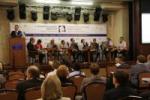- عربي
- Ukraine
- Economy
-
Investment
- Current Investment Trends
- Legal Conditions of Doing Business
- Investment Policy
- Competition
- Setting a Business in Ukraine
- Mergers and Acquisitions
- Taxation
- Import and Export
- Banks and Bank Regulation
- Convertibility and Profits Repatriation
- Currency Regulation
- Protection of Intellectual Property Rights
- Companies
- Travel to Ukraine
- About us
- Useful Sites
- Gallery
- News
Currency rates in UAH
| AED | ||
| BHD | ||
| EGP | ||
| KWD | ||
| LBP | ||
| OMR | ||
| QAR | ||
| SAR | ||
| SYP |
2015-07-06
| Kiev |  |
+32 |
| Donetsk |  |
+28 |
| Dnipropetrovsk |  |
+31 |
| Lviv |  |
+31 |
| Odessa |  |
+27 |
Economy
At the same time, Ukraine inherited a dysfunctional economic system and outdated manufacturing base from the Soviet Union. Today, Ukraine is going through a tough transition period. Reforms in the structure of its industries are greatly needed, but are being enacted either too slowly or not at all. Some industries do not have a closed production cycle and those that do are insufficient in number. The legal system is also flawed.
These problems are what hinder growth in the private sector. Ukraine’s economy simply does not offer the necessary conditions for the successful development of small-sized and medium business and so investment is slow to come.
Like most post-communist economies, Ukraine’s GDP dropped 52% when the Soviet Union collapsed. Industrial output shrank 48% and farm production fell 51%. Unemployment became a major problem. According to the ILO and the State Statistics committee, the official unemployment rate was 8.1% as for January 2013. But it is difficult to figure out the exact number though, when you factor in people who work short workdays, have days off and leave without pay, but also illegally employed people who collect unemployment benefits.
Today Ukraine has a grey economy, which some experts estimate amounts to half of the country’s GDP. This grey market employs about 8 million in Ukraine. This has also led to a major socio-economic gap, with 10% of the population earns 40% of all the revenues. Poverty is on the rise. According to opinion polls, the share of the population living below the poverty line grew from 14.8% in January 2010 to 15.2% in October 2011. According to UN data, 30% of Ukrainians are now living below the poverty line.
In 2000, Ukraine’s economy began to turn around as farm and administrative reforms kicked in and large-scale privatization picked up steam. According to government statistics, domestic industrial and agricultural markets have been growing ever since. These statistics also show that personal incomes have been growing as well. In the spring of 2002, the average monthly salary was UAH 400. In 2008 it was UAH 1 806 and in January 2014 it reached UAH 3 148. The food and consumer industries have been growing rapidly. Heavy-duty and super heavy aircraft called Ruslan and Mria were built by the Antonov Plant and became Ukraine’s most competitive product on the world market. Today, the development of hi-tech industries is a major priority.
From 2000 to the ‘Orange Revolution’ of 2004 Ukrainian per capita GDP actually rose compared to the GDP of its t hen CIS neighbors, from 61% to 68%. From 2004 forward, however, it declined precipitously, from the 68% to a low of 57% in 2013. In August 2008, Ukraine’s economy entered a steep downturn, with GDP plunging more than 30% in some industries. The situation in the country’s economy over 2008-2013 revealed serious problems that cannot be solved without major structural reforms across all sectors.
During 2010-2012, the economy was also showing signs of a gradual recovery. In addition to the resumption of economic growth, the Government initiated a number of ambitious reforms in December 2010. While Tax Code has been already adopted in December 2010, Tax is still underway. Pension reform to introduce a three-tier pension system has been adopted. A number of pilot projects aimed at boosting medical, education and residential services reforms are being launched. Another priority is land reform, which should grant farmers the right to sell and buy arable land. The successful implementation of reforms is the key expectation among both Ukrainian businesses and international investors.
In 2013 the Ukraine economy was in recession. Only agriculture and retail sales kept reporting solid gains, advancing by 6.3% yoy and 9% yoy respectively. That recession is about to accelerate in 2014, with some reports predicting the Ukrainian economy will experience a real GDP decline by about 4% yoy due to the fiscal measures that affect domestic demand as well as Russia’s trade restrictions, and higher imported utility products prices.
The current currency collapse is deepened by the economy’s loss of foreign currency reserves. Ukraine’s total debt is now estimated around $80 billion.
The IMF has initially indicated it would provide $27 billion, but the deal would be paid over 7 years in delivery. As in typical IMF deals, most of that $27 billion would go to cover payments to western bankers first, to ensure they are covered and protected.
Ongoing severe political crisis has aggravated long-lasting economic crisis
Ukraine has been high country risk long before the political crisis and conflicts erupted in late 2013/early 2014. The economic crisis developed following the suspension of an IMF funding programme in April 2011. Macroeconomic imbalances widened again, especially the current account deficit and the fiscal deficit, and downward pressure on the UAH increased. Foreign exchange (FX) reserves declined with accelerating pace as a result of recurrent central bank intervention to defend the then quasifixed exchange rate, capital flight and the financing of fiscal deficits. Since mid-2012, the Ukrainian economy has been in recession.
Since 2014, the violent conflict between government forces and separatists in east Ukraine – which has been ongoing despite two ceasefire agreements in September 2014 and February 2015 – and the related serious dispute with Russia (which annexed Crimea in March 2014 and supports the separatists) have drastically aggravated the economic crisis in Ukraine. A balance-of-payments crisis has evolved, FX reserves have dwindled despite large-scale international financial support, the recession has deepened, and a sovereign debt restructuring/ default is looming in 2015-2016.
Deep recession to continue in 2015
Real GDP dropped by -15.2% y/y in Q4 2014, following -5.3% in Q3, -4.6% in Q2 and -1.2% in Q1. This indicates that GDP contracted by about -6.5% in 2014 as a whole, weighed down by the conflict in east Ukraine, which has taken a significant toll on the industrial base and exports, undermined confidence and caused pressures on the financial system. Details of Q4 and full-year GDP are not available as yet, but the breakdown of Q1-Q3 shows that private consumption contracted by an average -3% y/y, fixed investment by a hefty -22%, exports by -10% and imports by -17%. Public consumption was roughly flat in Q1-Q3. Against the backdrop of the ongoing political crisis, the plunging exchange rate and rapidly rising inflation, Euler Hermes expects the downtrend to continue well into 2015 and forecasts a contraction of GDP by around -8%.
Gross external debt declined from USD 142 bn at end-2013 to USD136 bn in Q3 2014, but rose to about 90% as a share of GDP. Euler Hermes expects this already high ratio to increase to at least 115% in 2015, as a result of the UAH depreciation (95% of external debt is denominated in hard currencies) and forthcoming financial aid from international institutions.
Consumer Price Index CPI in Ukraine decreased to 100.40 Index Points in June of 2015 from 102.20 Index Points in May of 2015. Consumer Price Index CPI in Ukraine averaged 105.86 Index Points from 1991 until 2015, reaching an all time high of 385.20 Index Points in January of 1992 and a record low of 98.20 Index Points in June of 2002. Consumer Price Index CPI in Ukraine is reported by the State Statistics Service of Ukraine.
The inflation rate in Ukraine was recorded at 57.50 percent in June of 2015. Food and non-alcoholic beverages grew by 51.9 percent; housing, water, electricity, gas and other fuels - 157.2 percent; furnishings, household equipment - 51.1 percent; health - 39.8 percent; transport - 38 percent. Inflation Rate in Ukraine averaged 36.45 percent from 1995 until 2015, reaching an all time high of 530.30 percent in September of 1995 and a record low of -1.20 percent in June of 2012. Inflation Rate in Ukraine is reported by the State Statistics Service Of Ukraine.
Investments in fixed assets in Ukraine plunged 28.1% yoy in 2014 following an 11.1% yoy decline in 2013. The Donetsk and Luhansk regions demonstrated the strongest decline of 49.2% and 51.2%, respectively.
Unemployment Rate in Ukraine decreased to 10 percent in the first quarter of 2015 from 11 percent in the fourth quarter of 2014. Unemployment Rate in Ukraine averaged 8.56 percent from 2003 until 2015, reaching an all time high of 11 percent in the fourth quarter of 2014 and a record low of 6.50 percent in the third quarter of 2008.
The economy is expected to resume growth in 2016, however, it will remain in a fragile state. The IMF-mandated reforms should help improve government accounts, but they will upset private consumption in the near term.
Although indications from the 2016 data available so far are mixed, overall they look tentatively positive. In January, the drop in retail sales volumes reached merely ‑1.4% year on year, against a low base (retail sales volumes contracted by just over 20% for 2015 as a whole). Moreover, in early 2016 the consumer confidence index of GfK Ukraine, a market survey firm, continued to climb, to 54.1 in February, from a low of 41.1 one year earlier (the extent of the index falling below the 100 balance point is an indication of the extent to which negative consumer responses about the economic outlook outweigh positive ones).
Most importantly, in February the industrial sector, traditionally the backbone of the Ukrainian economy, returned to strong growth of 7.6% year on year - its first year on year expansion since July 2012. Utilities is leading among the improving industrial sector, according to January data, apparently benefiting from the increases in household tariffs. The export-oriented metallurgy and machine-building sectors, as well as chemicals, continued to fall sharply.
|
2006-2007 |
2007-2008 |
2008-2009 |
2009-2010 |
2010-2011 |
2011-2012 |
2012-2013 |
2013-2014 |
2014-2015 |
|
|
Industrial Production Index, % |
110.2 |
96.9 |
78.1 |
111.0 |
107.3 |
98.2 |
95.7 |
78.7 |
86.6 |
|
Increase/decline in retail turnover, real % |
128.8 |
118.6 |
83.4 |
107.6 |
114.7 |
115.9 |
109.5 |
70.4 |
79.3 |
|
Producer Price Index for industrial |
123.3 |
123.0 |
114.3 |
118.7 |
114.2 |
100.3 |
101.7 |
117.1 |
136.0 |
|
Consumer Price Index, % (of previous year) |
116.6 |
122.3 |
112.3 |
109.1 |
104.6 |
99.8 |
100.5 |
157.5 |
148.7 |
|
Investment in fixed assets, % (of previous year) |
129.8 |
97.4 |
58.5 |
99.4 |
122.4 |
113 |
88.9 |
71.9 |
98.3 |
|
Investment in fixed assets, % of GDP |
26.2 |
24.5 |
16.6 |
15.8 |
18.3 |
18.7 |
17.1 (2013) |
8.16 (2014) |
12.69 (2015) |
|
Official unemployment rate, % of working |
7.4 |
6.9 |
6.9 |
9.6 |
8.8 |
8.6 |
8.1 |
10.1 |
9.5 (Jan 1, 2016) |
Source: State Statistics Service Of Ukraine




